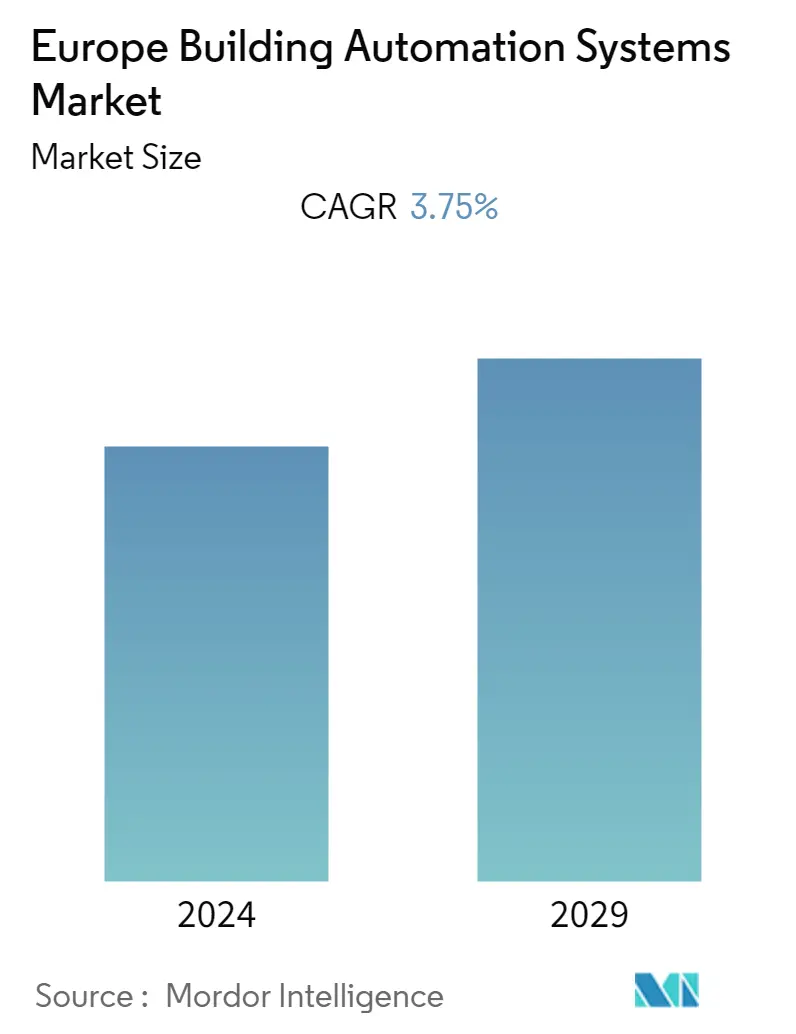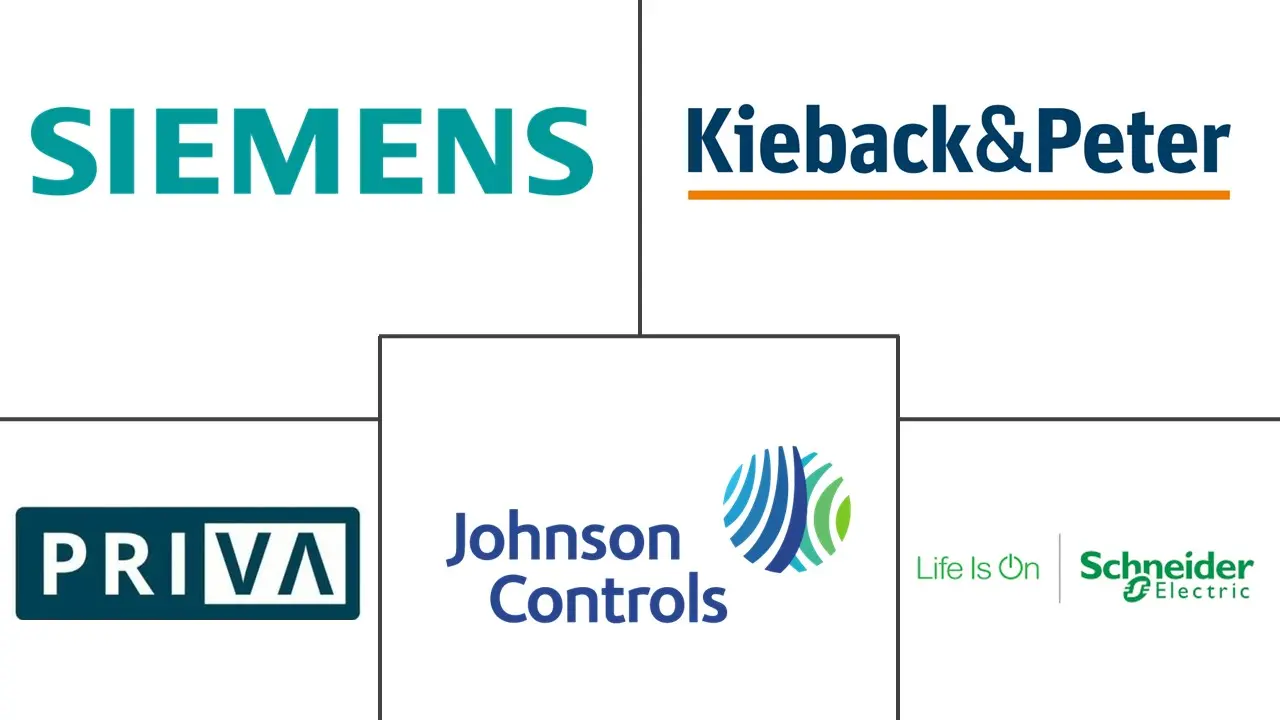Market Size of Europe Building Automation Systems Industry

| Study Period | 2019 - 2029 |
| Base Year For Estimation | 2023 |
| Forecast Data Period | 2024 - 2029 |
| Historical Data Period | 2019 - 2022 |
| CAGR | 3.75 % |
| Market Concentration | Low |
Major Players
*Disclaimer: Major Players sorted in no particular order |
Europe Building Automation Systems Market Analysis
The Europe Building Automation Systems Market size is expected to grow from USD 3.67 billion in 2023 to USD 4.41 billion by 2028, at a CAGR of 3.75% during the forecast period (2023-2028).
- A building automation system (BAS), also referred to as a building control system or a building management system, is a system that controls several electric, electronic, and mechanical systems throughout a building. The report tracks the revenue accrued by companies through the sale of building automation solutions worldwide. Components like building management systems, lighting controls, fire detection, HVAC controls, and security systems are included in the scope of the study and span across end users, like residential and commercial.
- The building industry is essential to meeting the energy and environmental objectives of the EU. Better and more energy-efficient structures will also raise living standards for residents, reduce energy poverty, and benefit the economy and society by creating green jobs and other advantages like better indoor air quality and health.
- The demand for Internet of Things (IoT) products is growing across Europe. The region's IoT adoption is now being led by Germany, the United Kingdom, and the Netherlands, while Eastern Europe and the Nordics are closely trailing. Although the manufacturing, housing, health, and finance industries are leading the way in IoT adoption, the retail and agricultural industries are also experiencing significant development. Demand for outsourcing is still being driven by a lack of qualified specialists and a growing willingness to outsource.
- Technology for building automation systems (BAS) has advanced significantly and is always becoming better with new capabilities. It is noteworthy that many building managers still manually operate HVAC systems because they have little faith in the building automation system. Far too many buildings with perfectly functional building automation systems have their equipment being run manually by the building operators, whether due to a lack of understanding or the building automation system not being configured properly by the installation contractors.
- With the COVID-19 outbreak, most commercial and industrial construction projects started at a slow pace, while some were canceled. Production lines at some HVAC manufacturers had to be put on hold for several weeks, and installers saw their new installation projects limited by sanitary guidelines. However, in European countries such as Italy, AHU sales benefitted from the increased ventilation demand due to COVID-19. After the pandemic, commercial and industrial construction projects started, which propelled the market growth.
Europe Building Automation Systems Industry Segmentation
Building automation systems exhibit functions such as control of the building's environment, operating systems depending on the energy demand, and monitoring the system performance, based on which the systems produce sound alerts as required. It centrally controls the building's heating, ventilation, air conditioning (HVAC), electrical, access control, and other interrelated systems.
The market is analyzed by tracking the components of building automation systems in terms of revenue generated across Europe. The scope covers automation controllers as per their application according to their specific or general functionalities. The integrated software is installed based on the configuration for controllers and supervisory software for computers. The field devices include sensors, actuators, valves, switch boxes, relays, and management field devices. As part of the vendor market share, only controllers and software are considered while arriving at the market shares. The impact of macroeconomic trends is also considered while forecasting market growth. Market players, including their key developments and growth trends, are studied for the global and European markets.
The Europe Building Automation Systems Market is segmented by Component (Hardware (Controllers and Field Devices), Software-as-a-Service), by End User (Residential, Commercial, Industrial), by Country (Germany, United Kingdom, France, Nordics (Denmark, Sweden, and Finland), Spain, Italy, Rest of Europe). The market sizes and forecasts are provided in terms of value in USD for all the segments.
| By Component | ||||
| ||||
| Software-as-a Service |
| By End User | |
| Residential | |
| Commercial | |
| Industrial |
| By Country | |
| Germany | |
| United Kingdom | |
| France | |
| Nordics (Denmark, Sweden, and Finland) | |
| Spain | |
| Italy | |
| Rest of Europe |
Europe Building Automation Systems Market Size Summary
The European building automation systems market is poised for significant growth, driven by advancements in technology and increasing demand for energy-efficient solutions. Building automation systems, which encompass various components such as lighting controls, HVAC systems, and security measures, play a crucial role in enhancing the energy efficiency and operational efficiency of buildings. The market is experiencing a surge in interest due to the growing adoption of Internet of Things (IoT) technologies and the integration of artificial intelligence and smart sensors in commercial buildings. These systems are not only vital for meeting the European Union's energy and environmental goals but also contribute to improving living standards, reducing energy poverty, and fostering economic growth through the creation of green jobs.
The market's expansion is further supported by regulatory mandates and the rising value of commercial real estate in Europe. Governments are implementing policies that require large non-residential buildings to be equipped with advanced building automation functions, thereby driving demand. The commercial segment, which includes offices, hospitals, and retail spaces, is witnessing increased traction due to the need for enhanced security and safety measures. Additionally, the market is characterized by intense competition, with major players like Siemens AG, Johnson Controls International PLC, and Schneider Electric SE actively engaging in partnerships and technological innovations to maintain a competitive edge. The post-pandemic recovery has also spurred growth, as construction projects resume and the demand for improved ventilation and air quality systems rises.
Europe Building Automation Systems Market Size - Table of Contents
-
1. MARKET INSIGHTS
-
1.1 Market Overview
-
1.2 Industry Attractiveness - Porter's Five Forces Analysis
-
1.2.1 Bargaining Power of Suppliers
-
1.2.2 Bargaining Power of Buyers
-
1.2.3 Threat of New Entrants
-
1.2.4 Threat of Substitutes
-
1.2.5 Degree of Competitive Rivalry
-
-
1.3 Industry Value Chain Analysis
-
1.4 Impact of Macro Economic Trends on the Industry
-
-
2. MARKET SEGMENTATION
-
2.1 By Component
-
2.1.1 Hardware
-
2.1.1.1 Controllers
-
2.1.1.2 Field Devices
-
-
2.1.2 Software-as-a Service
-
-
2.2 By End User
-
2.2.1 Residential
-
2.2.2 Commercial
-
2.2.3 Industrial
-
-
2.3 By Country
-
2.3.1 Germany
-
2.3.2 United Kingdom
-
2.3.3 France
-
2.3.4 Nordics (Denmark, Sweden, and Finland)
-
2.3.5 Spain
-
2.3.6 Italy
-
2.3.7 Rest of Europe
-
-
Europe Building Automation Systems Market Size FAQs
What is the current Europe Building Automation Systems Market size?
The Europe Building Automation Systems Market is projected to register a CAGR of 3.75% during the forecast period (2024-2029)
Who are the key players in Europe Building Automation Systems Market?
Siemens AG, Johnson Controls International PLC, Kieback&Peter GmbH & Co. KG, Priva Holding BV and Schneider Electric SE are the major companies operating in the Europe Building Automation Systems Market.

